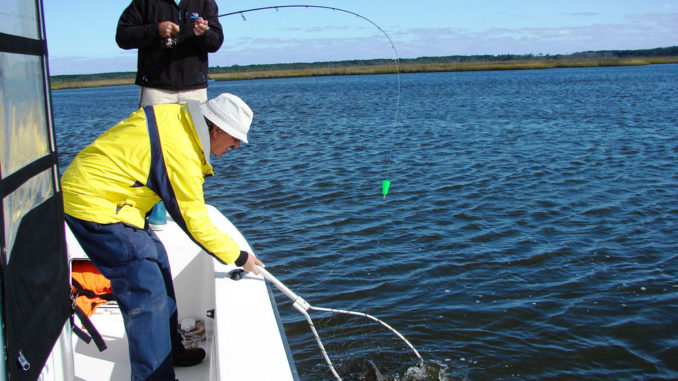
The Cape Fear area was hit hard by Hurricane Florence this fall, and then the remnants of Hurricane Michael added plenty of runoff a few weeks later. The full assessment of the damage and how these storms will affect fishing is ongoing, but one positive was that redfish and specks were feeding within weeks. Another is that no fish-consumption advisories have been issued.
Chris Stewart from the Wilmington office of the N.C. Division of Marine Fisheries said his agency’s primary concern was for striped bass in the Cape Fear River. Stripers were a major part of several fish kills immediately after Hurricane Florence, from as far inland as Wallace, where the Northeast Cape Fear flooded I-40. When the water receded, stripers, bass, catfish, bream, gizzard shad, eels and other species were left on the roadway and in the ditches.
Another large kill occurred over several days as high tides overflowed into Battleship Park across the Cape Fear River from Wilmington. Many of the same species, plus striped mullet, moved into shallow water in the park, apparently searching for water carrying more dissolved oxygen, before falling water left them stranded. Many fish were observed at the surface, gasping air, a sign of low dissolved oxygen in the water.
An electroshocking trip done by UNC-Wilmington’s Marine Biology Department in mid-October only produced a few fish, and the results were attributed extremely low dissolved-oxygen levels. NCDMF tests confirmed this.
Stewart said biologists have special concerns with striped bass; a restocking program has been ongoing for several years, and this has the potential to be a big setback. This is likely to be a slow season for stripers in the cape Fear fishery, and not a particularly good one for other species, but they typically recover more quickly.
Stewart said a bright spot was there were very few red drum, speckled trout and flounder in the fish kills. There have been good catches at Wrightsville Beach and near Southport since the hurricanes; biologists believe these fish moved downriver before the dissolved-oxygen levels dropped to critical levels. Another concern is how long the dissolved-oxygen levels will remain low and the fish will remain displaced.
Cape Fear River Watch and Waterkeeper Alliance have both reported that testing has found highly elevated levels of heavy metals in the Cape Fear River around Wilmington. They link the increased levels to flooding that overran Sutton Lake, a cooling reservoir for the Sutton Electric Plant just outside Wilmington, and the coal ash storage impoundment beside it. Duke Energy its tests show levels within the standards for drinking water.
The bottom line is, the after effects from Florence and Michael will affect fishing for a while, but no one has a time line for when all the damage will be known and how the recovery will proceed. The good news is fish began biting farther down the river soon after the storm and that has been improving.



